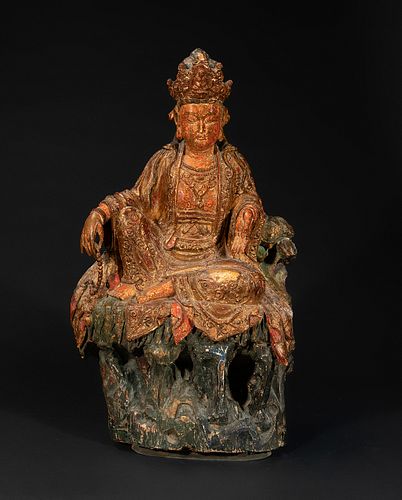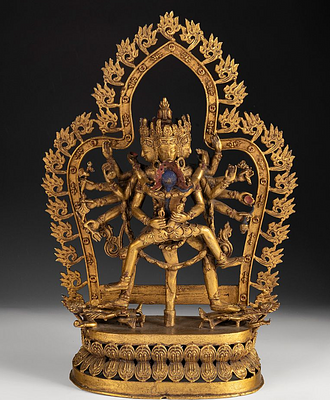Bodhisattva figure; China, 18th-19th centuries. Carved and polychrome wood with fine gold.
Lot 69
About Seller
Setdart Auction House
Carrer Aragó 346
Barcelona
Spain
Setdart Subastas was born in 2004 and is currently the first online art auction in Spain with solidity, prestige and reliability guaranteed by our more than 60,000 users. Setdart has a young, dynamic and enterprising team ready to successfully manage the purchase and sale of art works through custom...Read more
Categories
Estimate:
EUR€4,000 - EUR€5,000
$4,301.08 - $5,376.34
Absentee vs Live bid
Two ways to bid:
- Leave a max absentee bid and the platform will bid on your behalf up to your maximum bid during the live auction.
- Bid live during the auction and your bids will be submitted real-time to the auctioneer.
Bid Increments
| Price | Bid Increment |
|---|---|
| EUR€0 | EUR€10 |
| EUR€200 | EUR€25 |
| EUR€500 | EUR€50 |
| EUR€1,000 | EUR€100 |
| EUR€3,000 | EUR€200 |
| EUR€5,000 | EUR€500 |
| EUR€10,000 | EUR€1,000 |
| EUR€20,000 | EUR€2,000 |
| EUR€50,000 | EUR€5,000 |
About Auction
By Setdart Auction House
Jun 16, 2021
Set Reminder
2021-06-16 06:15:00
2021-06-16 06:15:00
America/New_York
Bidsquare
Bidsquare : Oriental Art Collection
https://www.bidsquare.com/auctions/setdart-auction-house/oriental-art-collection-7080
Setdart Auction House sofia@setdart.com
Setdart Auction House sofia@setdart.com
- Lot Description
Bodhisattva figure; China, 18th-19th centuries. Carved and polychrome wood with fine gold. Measurements: 55 x 30 x 15 cm Sculpture carved in wood and polychrome fixed gold representing the figure of Bodhisattva known in China as a symbol of universal virtue. In Mahayana Buddhism, he is associated with the Buddhist practice of meditation and, together with Sakyamuni Buddha and the bodhisattva Manjusri, he forms the Buddhist Trinity. As a bearer of compassion and help, his representations have become popular objects of devotion ("bakhti"), which, from an artistic point of view, favors the enrichment of the Buddhist pantheon, channeling it through his different representations. His iconography corresponds to that of an asexual and timeless being, of tranquil appearance, adopting postures derived from dance, such as the triple flexion or "tribhanga" characteristic of the first Indian representations. They usually appear richly adorned, in relatively active postures or also enthroned -as in the present case-, and usually dressed as the princes of each school and artistic period, which adds a great documentary value to them. In Buddhist iconography they play a role similar to that of the saints in Christianity, who, like them, will wear the halo of sanctity, in addition to the "usnîsa" between the eyebrows, like the figure of Buddha*, differing from him by a more worldly treatment, reflected in the richness of their clothing and ornaments, and by carrying in their hands attributes that identify him. In the Vajrayâna, his origin is derived from the five Dhyâni Buddhas and represents all the masculine divinities of the Buddhist pantheon.
- Shipping Info
-
In-house shipping available. Please inquire at admin@setdart.com.
-
- Buyer's Premium



 EUR
EUR CAD
CAD AUD
AUD GBP
GBP MXN
MXN HKD
HKD CNY
CNY MYR
MYR SEK
SEK SGD
SGD CHF
CHF THB
THB
















